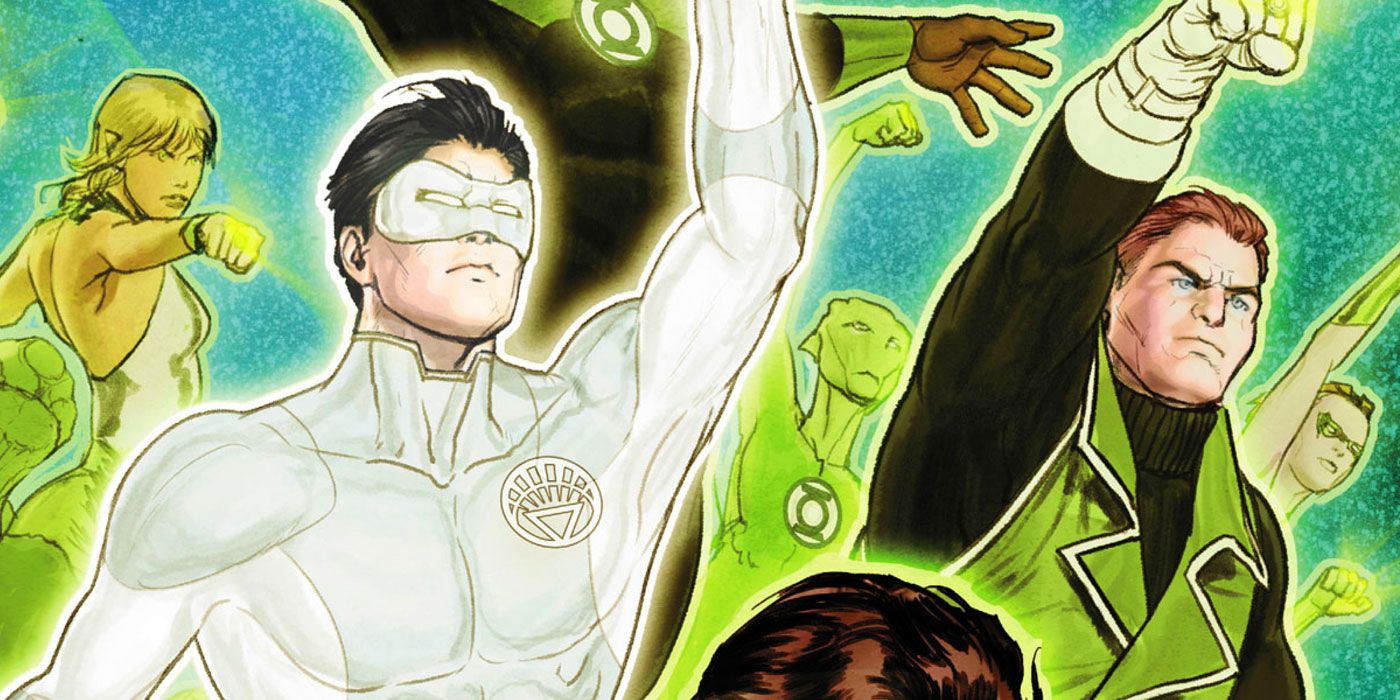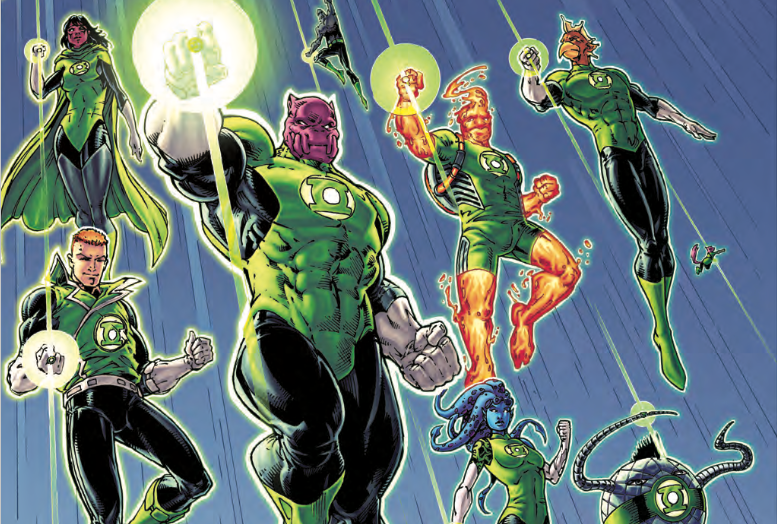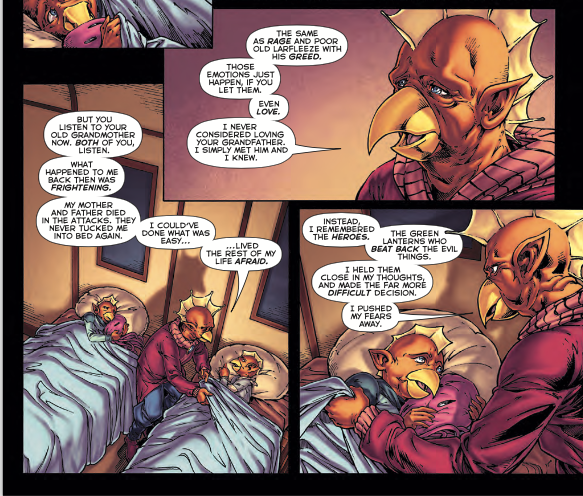This week's "Hal Jordan and the Green Lantern Corps" #13 by Robert Venditti and V. Ken Marion served as an epilogue to the title's "Bottled Light" arc, which saw Starro and Brainiac team up to conquer the planet Xudar, part of a grander scheme by Larfleeze to add the Green Lantern Corps to his collection. When the dust settled, the Lanterns emerged victorious, and this issue, titled "Heroes," explored the Xudarian civilians' view of a world rescued, as told by a survivor of the siege to her grandchildren, sixty Earth years in the future.
RELATED: Hal Jordan & the Green Lantern Corps Reads Like A Response to President Trump
Venditti and Marion's story also gave an opportunity to refocus the concept of Green Lantern, delving into its themes of the triumph of will over fear and other less noble emotions. With all of that in mind, CBR spoke with Venditti about the issue, the idea of Green Lantern, and how current events and a reader's perspective can affect how a story is read.
CBR: First, let's go back in time a little bit, thinking about what Green Lantern means. In the Silver Age, Hal Jordan was chosen as Green Lantern because he was "without fear." The modern equation is that Lanterns are "able to overcome great fear." This change didn't originate with you, but I'm wondering what you see as the fundamental meaning or value in this shift.
Robert Venditti: I think as a character, when you're writing stories, you don't really have a story without conflict. As much as we all love our heroes, we have to put them through the wringer in order to tell stories that are exciting and test their limits. I think if you have a character that is incapable of fear, it kind of takes the conflict out of it. Overcoming great fear, that's something you can put the conflict into and also something that's more relatable to the audience. We all know what it feels like to have fears and we know, hopefully, the triumphs of overcoming them, as well. I think that is really integral to who the Lanterns are and their concept in the modern DCU. And obviously the theme was very important to the issue, as well.
We didn't see it this issue, but I also thought it was interesting that in the "Bottled Light" arc, the Sinestro Corps were teaming up with the Green Lanterns, a team up of will and fear. How does that play into the themes of "Green Lantern?"
You're going to see a lot more of that in the next arc. This was kind of a breather issue between the two [arcs], where if you haven't been reading the series up to now, you can read this, catch up on what the concept is and who the characters are and what's going on, where we are in terms of story. And if you have been reading the series, there are a lot of teasers about what's coming up, about future storylines that we're going to do. And that's not theoretical, some of that stuff is already executed in script and being drawn as we speak. These are actual events that are going to take place.
As far as them teaming up with the Sinestro Corps, one of the things I like to do with the "Green Lantern" series is -- all the Green Lanterns are chosen because they have the ability to overcome great fear, and I think that there's a tendency to lump all the Green Lanterns, not just the human Green Lanterns, as if they're all the same. They're all the same person, they all operate the same way. What I try to do with each of our four leads, which is Hal, John, Guy and Kyle, is not just show them overcoming great fear but also showing the differences in how they apply their willpower. Hal does it with a sort of gut instinct, hurling himself into harm's way. There's a boldness about him. John Stewart does it more through his strengths; he sits back, waits, gets all the chess pieces on the board and strikes at the right time. Guy is a person who will take every punch in the face he can take so that nobody else has to take them. These are all demonstrations of great will, and I think the same is true of the Sinestro Corps. Yes, they all wield great fear and are powered by fear in some way, but how is that different? We'll come to see over the next few arcs as these two corps try to work together how fear operates differently for them and where that power comes from now that they're being led by Soranik, the daughter of Sinestro, rather than the original Sinestro himself.
The narrator says something in passing in the issue that I thought was interesting, that most of the Green Lanterns hale from planets she's never heard of, highlighting that these are strangers who are protecting people who are not their own. That's always been in the Green Lantern idea but hasn't been emphasized as much.
I wanted to tell a story that was a kind of ground-level perspective. So much of what we do in the series is told from the sky looking down, I wanted to do something from the ground looking up. We're relating events in this issue that were told in the previous arc, but we're telling them in a different perspective. I think we take for granted the diversity of the Green Lantern Corps. This is a police force made up of members of a vast and diverse universe. They're officers from individual communities that come together to police everything as a whole. To see what it looks like from a ground level perspective, that is what I wanted to show.
I think that [issue artist] Ken Marion, this is first time on the series and my first time working with him, we really gave him a lot here. Like nine million characters, and creating a whole culture in the Xudar of the future and these things. He really did a great job with it.
As a little nugget, the character who narrates the story, Somar-Le, she actually makes her first appearance back in issue #9 when [Green Lantern] Rot Lop Fan creates a construct and hits the barrier of Brainiac's bottle, and that disrupts the communication between all the little Starro spores. One falls off her face, she says, "I'm Somar-Le, has anybody seen my parents?"
We see that from her perspective this issue, when she tells her grandchildren about the siege. Do you see the story as a reminder of the aspirational role of superheroes, and the power of real-life heroes?
Yeah, absolutely, I would love for it to be viewed that way. Obviously, you don't have to be a superhero to be heroic. This is a woman who is a grandmother. Her grandchildren don't know much about her but she is imparting on them a life lesson that will teach them to have no fear and overcome our worst instincts in terms of rage and greed and all these other things. Each of us, I think we tend to look a lot toward history and the past for our heroes and I think that's great, but our heroes are also present and right there. We have the opportunity to inspire our children and grandchildren in the way that hopefully our role models have done for us.
The Xudarians have been part of the Green Lantern mythos for ages, but what led you to set the "Bottled Light" story arc in this environment, with "Heroes" following?
One of the aspects of "Rebirth" that we're really trying to tap into while pushing the characters and story forward is that we're also embracing the long, storied histories and legacies of all these characters. In the Green Lantern mythology Xudar, going back to Tomar-Re, kind of embraces that. That was one reason I wanted to do it, but I also wanted to because we have Tomar-Tu, the son of Tomar-Re, as a current Green Lantern, and I want to, in addition to the four leads, focus on some of the alien races. This was an opportunity to, if I'm going to set it on a world, let's set it on a world that one of these characters calls home and make it relatable that way. Have a mini-plot there with Tomar-Tu. And we aren't done with his story yet.
I know you didn't plan it this way, but this issue came out the week after the presidential inauguration and Women's March. Some folks on both sides of that equation are likely to see a message here. Does viewing the story through this lens affect the message you were originally going for?
It's an interesting question. I was in Atlanta last weekend for ALA [the American Library Association Midwinter Meeting]. We were downtown and there was a march that came through that was sizable, and it was a part of what was going on throughout the country. All these things are of the moment. For me as a writer, I try really hard to not go into any sort of story in a way that a reader would know what my point of view is on a topic. For example, "The Surrogates" is a story I wrote a long time ago. It's about technology, and I have just as many people come up to me and say, "You must really hate technology" as say "You must really love technology."
We all know it feels like when we experience a work of art, whether it's a film or a book or what have you, and it feels like it should come with a hammer to beat yourself over the head with. Because the point of view is not that of the characters but whoever created the story. I always try to avoid that, because I want the audience to get lost in the story and relate it however they can to their own life and hopefully take something positive away from it.
This is a story I pitched to DC well over a year ago. It was meant to do a lot of things. In one aspect, I knew we were going to have a fill-in issue here, a breather between two arcs. I wanted it self-contained. In another aspect, some of the earliest comics I read that inspired me to want to be a writer myself were Kurt Busiek's "Astro City," which is very much an on the ground, looking up at the sky view of superheroes. So I wanted the point of view to be something that was in that tradition.
But, you know, the moment being what it is, when you read the issue… I don't know how to articulate this! [Laughs] It can convey these things. But I don't think that's bad. As a writer, if I can tell a story that can make people think, or inspire them, or be positive in some way, that's what it's all about.



